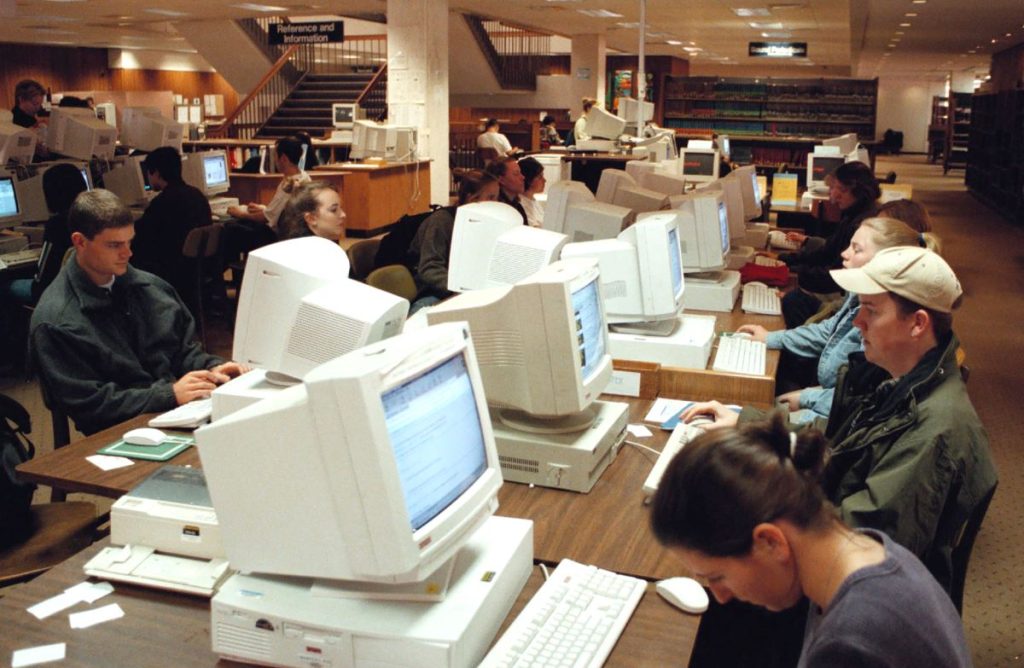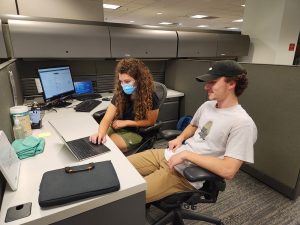There is a running joke that tech people always work in basements, so when the ITS Service Desk staff were told they would be moving from the lower level of one library to that of another, it seems unlikely it would have registered any excitement. However, nothing could be further from the truth.
As the Service Desk marks its 20th anniversary in Robert B. House Undergraduate Library, staff members — present and past — are fond of their home in the heart of campus and how it has transformed their services.
“When we moved into the Undergrad from Wilson Library, it was definitely a step up,” ITS Service Desk Manager Christina Artis said. “We were still in the basement, but it was more modern looking, had matching furniture and we had windows!”

Artis, who was initially hired as a technical consultant in 1999, said she felt like a “fish out of water” in Louis Round Wilson Library.
“I was coming from a corporate environment, so being in Wilson was very different because it was dusty and old and there was no privacy,” Artis said. “When we moved to the UL, we had a lot better space for our customers and the thoughtful design gave our service more legitimacy.”
Creating the Service Desk 2.0
Legitimacy was important. It was only a few years before the move that the Service Desk even existed. The ATN Help Desk, as it was known then, consisted of a small office suite tucked into Wilson Library’s side entrance. Primarily tasked with supporting a handful of faculty and staff who used a few special software applications, it was an obscure space for a small service.
At the time, the Help Desk had fewer than 20 senior analysts and phone consultants to support campus.
However, in 1997, everything changed. The University launched the Carolina Computing Initiative and the need for a more robust technical support system — in the form of a devoted service desk — was born.
With the CCI program launch came a restructuring and rebranding of the Help Desk. As the needs of campus changed, so did the Help Desk’s names and services — what was formerly the Help Desk became the IT Response Center and later, the ITS Service Desk.
“I’d say the biggest change to the Service Desk over the years, other than location, is how it has continued to evolve as its customers have,” Student Affairs IT Director Chris Williams said. “When it started, we taught students how to use a mouse. Now we’re helping them figure out the most random and complex questions.”
A different type of networking
Williams, who started his IT career as one of the first student technical consultants for the newly formed ResNET and Service Desk, owes his current professional life to his work with both ITS services.
At the time, Williams lived in one of the few dorms on campus with network access. In attempting to configure his computer for access, he ran into ResNET support personnel who noticed his aptitude for troubleshooting.
“Had I lived anywhere else on campus, I easily could be in a whole different industry right now,” Williams said. “That’s what set me on the path of IT — because I got the ResNET job, which led to the Service Desk. I worked them both until I graduated.”
A new place for a new headspace
For the Service Desk, the 2002 move was not just one of location, but also one of evolution as the recognizable “face” of ITS. With its more centralized location and open floor plan, the Service Desk saw its interaction with the campus community grow in proportion to its staff’s size, internal collaboration and knowledge.
Currently, the Service Desk has as many as 50 people on staff ranging from students to full-time senior tech specialists to walk-in, chat and phone tech support analysts.
“Over time, I saw growth with everybody on the staff because they started taking on varied roles and were not just stuck doing one thing,” said Cherritta Nickerson, who worked for the Service Desk two decades ago.
“The staff’s growing internal knowledge and collaboration improved our level of providing support to campus.”
Nickerson, now a supervisor with ITS Voice Services, was one of the first consultants hired in 1998 — specifically to bolster campus tech support in anticipation of increased volume from the CCI program.

“The Service Desk stands apart,” Artis said, “by its collaboration, culture and the people who we have here.”
Growing for the next decade
During its evolution from an out-of-the-way set of basement offices to its current status as a go-to hub for tech support, the Service Desk always maintained its central focus of customer service. As its current staff look forward to the next 20 years, that focus remains unchanged.
“I hope the campus community continues to see us as a helpful resource that’s meeting their needs,” Artis said. “And that it continues to be a fun place to work. When you enjoy what you do, it shows in your work.”
